
Cameras from the Swing Era
Watch the Birdie!
The following links will direct you to topics discussed on this page:
- The Beau Brownie
- The Baby Brownie
- The Brownie Vanity
- The Brownie Bantam
- The Kodak Six-16
- The Brownie Hawkeye
- The Brownie Bullseye
- The Brownie Synchro Reflex
- The Univex Mercury Model CC
- The Rolleiflex Cameras
- The Polaroid Cameras
- The Pentax Auto 110
- The Bolex H-16 16mm Movie Camera
- The Keystone K-29 Movie Camera
In addition to these topics, we have a Calendar of Swing Dancing in DC, a Directory of Vintage Clothing Stores and a Guide to 1940s Collectibles. Thanks for tuning in! Feel free to Contact Me if you have questions or want to share photographs and camera stories with the rest of the readers.
Vintage Cameras
I'm not really into photography as much as other hobbies. I have (somehow) managed to hang on to most of the cameras that I have owned ever since I was a kid. Thus, by default, I now have a camera collection. All of the cameras shown here are in working order (if you can find film for them...) I went through all my albums and I was able to find examples of contemporaneous photos that were taken by each of these cameras.
By the way, here is the webpage of another collector who takes photos with vintage cameras.
Let's start off with a camera that belonged to my mother:
Kodak was very successful in marketing simple box cameras with fixed focal length that were easy to use and inexpensive. Kodak was not without its competitors as these ads from a 1930 Sears Catalogue show.
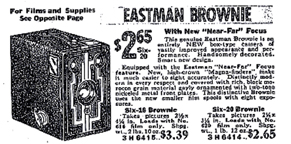
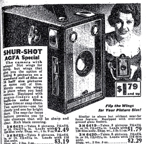
Simple Box Cameras
$2.65 in 1930 dollars is about $29 in 2009 Dollars
Click to Enlarge
From 1928 to 1933 Kodak made several colored and deco-styled cameras that were designed to appeal specifically to the style-conscious women of the twenties.

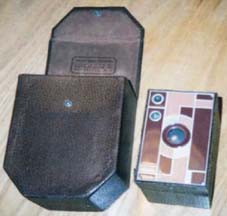
The Beau Brownie (No. 2A) in Rare Rose Pink
Coordinated Leatherette Carrying Case
Click to Enlarge
In 1928 Kodak hired Walter Dorwin Teague, a well-known American industrial designer to create cameras with a classier, more elegant look. Teague created the 1930 Beau Brownie camera with flat, geometric, enameled decoration that reflected the new taste for modern abstract pattern. The camera coordinated with other accessories such as compacts, cigarette cases, lighters and lipstick holders.
The camera was offered in five different color combinations: Maroon/Black, Light Blue/Medium Blue, Brown/Tan, Rose/Pink, and Green/Aqua Blue. For each color combination, both a No. 2 (2¼ x 3¼ inch pictures on 120 film) and a No. 2A (2½ x 4¼ inches on 116 film) size was available.

The "Tres Beau" Beau Brownies
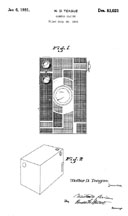
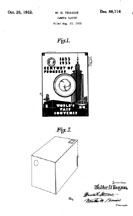
Walter Dorwin Teague's Patents for the Beau Brownie The Beau Brownie Patent D- 83,021
Special Brownie to Celebrate the Century of Progress Exhibition, Patent D- 86,116
Click to Enlarge
The most prominent feature of these cameras was their shiny enameled faceplate, but the complementary "leather look" material covering the body also provided interest and a feeling of opulence. The big opening on the faceplate is the lens; the two smaller openings are the view finders.

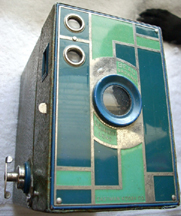
Comparison of MInt Conditiion and "Normally Found" Condition
(left) Mint (right) Normal
Click to Enlarge
The camera takes rectangular pictures, and thus, one had the option of making images in portrait (long side vertical) or landscape (long side horizontal) format. There is a separate separate view finder for each format.

Closeup of the "Leather Look" covering
Click here to see more of these beautiful cameras!
Here is a lovely picture that my Mom took with the camera. The photo is dated September 1938 and is labeled "Tommy and V. at Norwood Park" The camera for young moderns seems to have done a great job of capturing the youth and vitality of the moment.
 Photo taken by my Mom in 1938
Photo taken by my Mom in 1938My research indicates that this camera cost about $4.25 in 1930; at that time, my dad had a job that paid ten cents an hour. He would have had to work for more than a week to pay for this camera. At today's minimum wage of $5.25 per hour, this camera would have cost $315, about the cost of some digital cameras. This was a luxury item.
- DESIGNER: Walter Dorwin Teague (Design Patent D-83,021)
- MANUFACTURER: Eastman Kodak Company
- NATIONALITY: American
- PLACE MANUFACTURED: US, NY, Rochester
- INTRODUCTION DATE: Oct. 1930
- ORIGINAL LIST PRICE: $4.25
- FUNCTIONAL TYPE: Box rollfilm
Of all things, a Rose Beau Brownie shows up in the 1984 film Johnny Dangerously, a spoof of old Warner Brothers Gangster Films. At the graduation of Tommy Kelly (Griffin Dunne), Ma Kelly (Maureen Stapleton) says that "It's time for the Camera". She drags out a Beau Brownie, but it has been converted to a whisky flask.
In order to update the original box Brownie, Kodak commissioned Walter Dorwin Teague to create a more modern and convenient box camera using the new wonder material, Bakelite. The Baby Brownie emerged as a small basic camera (in the art decó style), with a flip-up frame viewfinder. The shutter is operated by the lever under the lens. Cameras made for export have "brief/time" button, above the lens. Both of these cameras were made in the USA. The cameras were manufactured from 1934 to 1941 in the USA and from 1948 to 1952 in the UK.
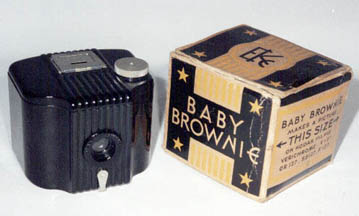
The Baby Brownie and Original Box
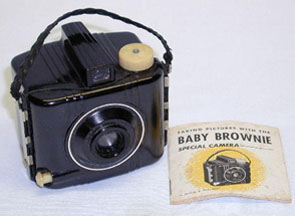
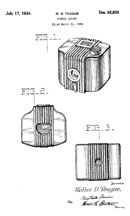
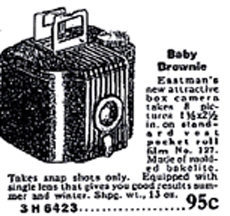
More Baby Brownie Front View with Instruction Book
Walter Dorwin Teague Design Patent D-92,830
$0.95 in 1935 is equivalent in purchasing power to $30 in 2009
Click to Enlarge
Here is a summary of the Technical Data:
- DESIGNER: (Design Patent D-92,830) : Walter Dorwin Teague
- MANUFACTURER: Eastman Kodak Company (US) and Kodak Ltd. (UK)
- PRODUCED: between : 1934 - 1952
- LENS: Meniscus
- SHUTTER: Rotary
- FILM SIZE: 127
- PICTURE SIZE: 6 x 4 cm
In 1912, Kodak introduced a "Vest Pocket" Camera that was a "breakthrough technology" for its day. The pocket-sized folding camera looked almost exactly like the larger folding Kodaks but used a new small film size. The little rolls of film yielded eight 1 5/8" X 2 1/2" exposures each—large enough to make contact prints but small enough to keep the camera palm-sized. The so-called "miniature" camera first retailed at $6.00—far less than the larger folding models—and became popular with soldiers during World War One.

1935 Sears Catalogue Ad for the Kodak Vest Pocket Camera
$10.25 in 1935 is about $310 in 2009
Click to Enlarge
The "Vest Pocket Model B" was introduced in 1924, and included several new design features including the "autographic" window on the camera back. By sliding a small door open, the photographer was able to inscribe some information about the picture through the backing paper, directly onto the film—a distant ancestor to today's "time stamp" feature in digital cameras.
In the 1920s, Kodak created a line of "Vanity" cameras that dressed up the camera with Art Deco plumage and enclosed it into a styled vanity case that included a mirror and lipstick. This was quite similar in function to the small digital cameras that ladies carry in their purse to record significant moments. Once again, Walter Dorwin Teague was called upon to give this ensemble a distinctive styling.
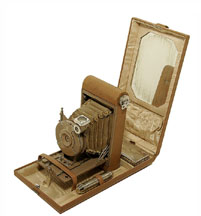
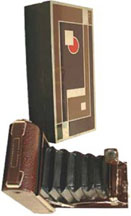
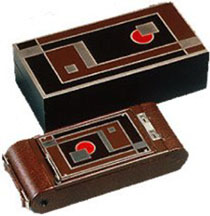

The Kodak Vanity Camera
Art Deco Styled Camera and Case
Walter Dorwin Teague Design Patent D-82,918
Click to Enlarge
35mm film, originally developed for cinematic use, was adapted in the mid teens for still photography by several camera makers, especially the Leica (Leitz Camera). When Kodak saw the success of the Leica, it developed a method to make 35 mm photography affordable. Several expensive models such as the Retina and Ektra were made, but only penetrated the high end market. One inconvenienece to the general public was that loading 35mm film in the Leica required a darkroom. Thus, Kodak developed the disposable 35mm cartridge and introduced it in 1934. The Bantam was a project to extent this technology to the general mass market.

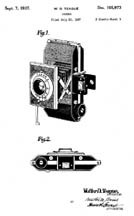
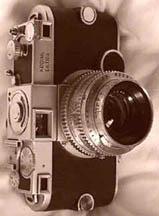
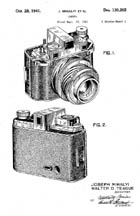
The Kodak Upscale 35 mm Cameras: the Retina and the Ektra
Walter Dorwin Teague Patent for the Kodak Retina D-105,793
Teague and Mihalyi Design Patent for the EktraD- 130,202
Click to Enlarge
During the first round of Bantam design, there were three different, but related visual designs that employed either Bakelite or cast alloy bodies. The original Bantam used Bakelite and weighed only 8 oz. The upscale models used alloy bodies that were still light, but over twice the weight of the Bakelite original.


Ads for the Bantam
(left) Mid 1937 (right) Mid 1938
$87.50 in 1938 is equivalent to about $2,700 in 2011
Click to Enlarge
Most early Bantam models were folders but in 1938 an entry level modelwas introduced with a "popout" design, improving its "pocketability". (More technical data on the Bantam can be found here.
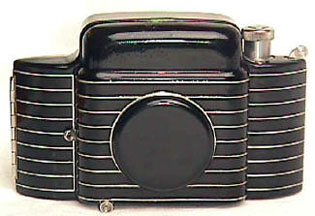
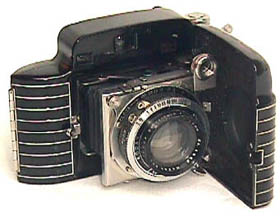

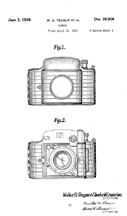
The Brownie Bantam
Front View Closed, Back View, Front View open
Walter Dorwin Teague Design Patent D-99,906
Click to Enlarge
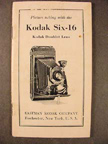
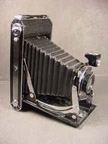
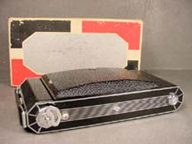

The Kodak Six-16
$3.85 in 1935 is the same as $120 in 2009
Click Photo to Enlarge
We are indebted to our friend "Acme Ron" from Phoenix for these photos of the Kodak Six-16
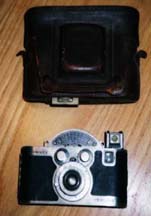
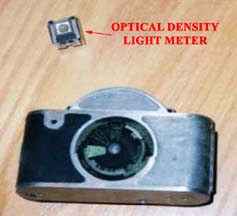

The Univex Mercury Model CC
(left) Front View with Case
(middle) Back View with Optical Density Light Meter Detached
(right) 1939 Ad for the Univex Mercury
Click to Enlarge
This camera belonged to my Uncle Ralph. He was very trendy. As I recall, he was always into anything "modern" whether he could afford it or not. He had a bunch of fancy cameras and gave me this when I was about 16. The Mercury is a bit complicated because it does not accept roll film --- you must buy film stock and wind it onto the camera's drum in the darkroom.
The Univex Mercury is known as a "half-frame" camera because it places two rectangular pictures in a single 35mm square frame. For this reason, it is very economical --- you can get 72 exposures on one reel of film. You have to do a whole lot of work to use the camera, since focus, exposure and depth of field are calculated by hand.
Sometimes called the Mercury CC, the Univex Mercury was a very early American venture into the new (at the time) world of 35mm still cameras. It first appeared in 1938. It is an odd-looking, but strangely handsome camera due to the rotary shutter, which required a large hemisphere on the top of the camera. The lens and twin dials on the top (one cocks the shutter, the other sets the shutter speeds) give the camera an attractive Mickey-Mouse appearance. But if you imagine the top "chopped-off", the Mercury does not look that different from other 35mm cameras of the time, such as the Leica. It came with a 35mm f3.5 focusing lens (equivalent to a 50mm in the full-frame format). It allows apertures to f22 and speeds of B, 1/20 - 1/1000. You can do close-focusing to 1.5 feet.
The camera has two "cold" flash shoes, meaning that a flash could be attached to the camera, but it could not be electronically synchronized with exposure of the film. Thus, in addition to all the other calculations, you had to set off your flash manually at exactly the same time you unleashed the shutter. One shoe is for the flash and the other is for the VERY HARD TO FIND optical density light meter, shown in the second picture. The light meter is just based on layers of paper! The brighter the light, the more layers it will shine through. You get a little number from the meter and then you plug it into the table printed on the circular part of the camera (first photo). Combining this with your best estimate of the distance to your subject, you get an appropriate F-Stop.
The camera lens has an interchangeable mount (somewhere around 7/8"), so other lenses might have been planned. There is Tripod socket and cable release connection which is pretty versatile for today, let alone 1938. It would be a large camera by today's standards, but it was very convenient -- and small -- in 1938. My uncle left me a real rarity --- the original leather case!
The Mercury used regular, perforated 35mm film on special reels (similar to 35mm cassettes without the covers). So if you want to use it, you have to have a pair of these reels and load them yourself. The loading must take place in the dark, so you cannot change film outside of the darkroom. Film leader is required to prevent fogging. The exposure counter only runs to 36 so longer rolls cannot be conveniently used. The camera sold quite well at the time, but the onset of World War II soon brought a demise to camera sales and production.
Probably the best-known of the Univex cameras, the Mercury has a distinctive appearance, due to the housing for the rotary focal plane shutter which extends above the top plate like a halo. This shutter is similar to that found on a movie camera. It has a 1/10 second rotation, and varying shutter speeds are obtained by changing the size of a slot in the shutter. It is reputed to be extremely accurate and reliable.
The Mercury Model CC, now usually called the Model 1, was introduced in 1938. When originally introduced, it had a 35 mm. f/3.5 Wollensack Tricor lens, and cost $25. (Something like $1500 today!) Other verions have a Wollensack f/2.7 Tricor lens or a Wollensack f/2 Hexar lens. The rotating focal plane shutter gives speeds from 1/20 second up to 1/1000 second, but a special version was produced for a very short time with a top speed of 1/1500 second. With the f/2 Hexar lens, this version cost $65 in 1939, and the limited production (about 3,000 are believed to have been made) means that this now a rare camera (unlike the standard model, which is fairly common in the US, although not so common in Europe).
Here is the design patent for the exterior of the Mercury. If you'd like a copy of the manual for this camera, Contact Me. The file is about 3.5 mb, and I'll e-mail it to you.
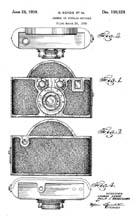
Univex Mercury Design Datent D-110323
Click to Enlarge
Below, is a picture that my Uncle Ralph made in July of 1941. It shows my beloved Uncle Tony (the Zoot Suiter) and some of his friends on a hot day. They are carrying rolled-up towels and I'll bet that they were on their way to go swimming with a couple of sweeties. They are waiting for a streetcar outside the Four Queens bar --- possibly, they had ducked in for a cold one... At any rate, those Hollywood pants and spectators are to die for! The little Mercury did a great job of capturing this scene.
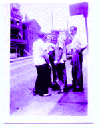
Uncle Tony and his pals
on a hot July day in 1941
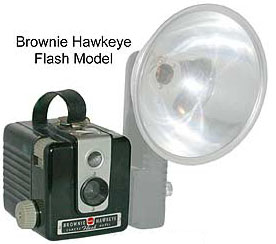
The Brownie Hawkeye Camera with the Kodalite Flash Holder
For the longest time, this was the only camera that my family used. I think that this is one of the most beautiful uses of plastic that I have ever seen in a commercial product. Without the flash, the proportions are maginificent. The little gray tabs on the top are symmetric --- one releases the shutter and the other opens the case. I always think of a puppy when I handle it -- there is something very welcoming and friendly about the camera. The separate flash makes it lopsided and a bit clumsy. I remember that when we got the Hawkeye, it was a lot more attractive than the Beau Brownie box camera shown above. The Deco styling and shiny black plastic made it look really "Jet Age" to me, anyway...
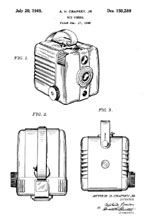
Brownie Hawkeye Design Datent D-150,289
Click to Enlarge
The camera takes 12 square exposures, so it only has one view finder (Compare with the Beau Brownie above). The opening for the view finder is on top of the camera between the gray tabs. The aperture for the view finder is above the lens on the front. Operation of the camera is absolutely simple: you hold it at waist level, look down into the view finder until you see what you want and snap. You have to manually wind the film with the little gray knob.
Starting in 1949, the Hawkeye was produced in two models. The 1947 model did not have a flash attachment; the 1950 model incorporated the Kodalite Flash gun, with a hot trigger to the shutter release. The flash attached with 'Pin & Screw' contacts.
The 1950 model can be easily distinguished from the 1949 model in two ways (1) by the word "Flash" below the red dot Kodak emblem on the front; and (2)The earlier model has a metal film wind knob, while the latter has a gray plastic knob.
The 1950 model was also produced in France as the Brownie Flash and exported, presumably to Spanish-speaking countries, as the Brownie Fiesta, Flash Model.
- MANUFACTURER: Eastman Kodak Company
- PLACE MANUFACTURED: US, NY, Rochester
- INTRODUCTION DATE: Sept. 1950
- ORIGINAL LIST PRICE: $6.95
- FUNCTIONAL TYPE: Box rollfilm
- Manufactured : 1949-51 (non-flash)
- Manufactured : 1950-61 (flash)
- Lens : Meniscus
- Shutter : Rotary
- Film Size : 620
- Negative Size : 6x6cm
Here is a photo that my mom took with the Hawkeye in about 1953; I am dressed in my little league uniform. I played first base for a team sponsored by the Brown and Vaughn Agency --- they were real estate developers who specialized in destroying the countryside and filling it with planned developments.

On my way to a Little League game
captured by the Hawkeye in about 1953

Brownie Bullseye (Flash)
Click to Enlarge
I spent so much time fooling around with my parents' Hawkeye that they gave me this camera just so that I would not run the film out of theirs. I'm sorry to say that I just didn't like it at all. It is bulky and heavy and has none of the grace of the Hawkeye. I found it uncomfortable, ugly and hard to use. On the other hand, it was a Gift, so I always kept it very neatly in its box. The lack of utility of the camera has led to its near-perfect preservation.

Cover of the Directions Booklet
for the Brownie Bullseye Camera
The photograph does not show the sheer bulk of this heavy Bakelite camera. In places, the case is over 1/4 inch thick, discouraging you from carrying this thing very far. The camera is big because it uses a rotary shutter, sort of like the Mercury. The focusing Twindar lens is housed in a single speed shutter that is preset at 10 feet for general snapshots. Once an exposure has been made, an interlock acts on the shutter release and a warning symbol appears in the viewfinder, directing you to wind to the next exposure. The flash gun attaches with "hot" Pin & Screw contacts. The camera also has a tripod socket. Because the camera produces a rectangular negative, you have the option of 'portrait' (the default), or 'landscape' photographs. For the latter, the booklet avises you to "hold the camera shutter-button side up."
- MANUFACTURER: Eastman Kodak Company
- PLACE MANUFACTURED: US, NY, Rochester
- INTRODUCTION DATE: Aug 1954
- ORIGINAL LIST PRICE: $12.85-$15.00
- FUNCTIONAL TYPE: Box rollfilm
- Manufactured : 1954-60
- Lens : Twindar
- Shutter : Rotary
- Film Size : 620
- Negative Size : 6x9cm
I still don't like this camera; I am pretty certain that we used it to take the following picture of me and my 1954 Volkswagen. I remember that my mom had left the Hawkeye at my grandfather's house and I was desperate to take a photo of my new (used) car; I think that this photo was taken in the fall of 1960. That's a National Honor Society pin on the lapel of my suit. What a dork...

The new (used) Volkswagen
Fall of 1961.

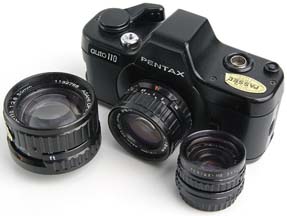
The Pentax Auto 110
A Superb Miniature Camera System
Click to Enlarge
After I went to college, I was generally too poor to take pictures. That's really too bad, because I have very little record of that period. When I finished school, I had to travel a lot and it was very difficult to carry enough camera gear to take pictures. Kodak introduced the 110 format in the early 1970s and made it possible to carry a reasonable camera in you shirt pocket. The things were really cheap and were almost disposable. I used a number of them, and do not have any to show you.
In the late 1970s, Pentax came out with the Auto 110 system --- basically it was a subminiature version of everything that you would carry in a normal camera bag --- a single lens reflex (SLR) camera with automatic light meter and interchangeable lenses --- and an auto winder. This was absolutely wonderful. I carried this camera in my "recreation bag" --- in addition to the Auto 110, I had a Walkman, programmable handheld calculator, and a palm-sized scanner. Later, I augmented this with a Watchman. The Auto 110 was spectacular! I used it regularly until Olympus came out with the XLR line that are even more convenient.
The Pentax Auto 110 came a 24/2.8 'normal' lens, a 50/2.8 telephoto lens, the AF130P flash w/case and the Auto 110 autowinder. The 24/2.8 lens has a Pentax skylight filter and the 50/2.8 has a Pentax T86 close-up lens for macro work. Each item in the system came with its own Pentax bubble case. The flash and autowinder use normal AA bateries.
A Pentax Advertisement in March 1979 said: "The Pentax System 10 is by far the smallest and lightest SLR of its time. System 10 lenses are so fine and so precise, that they can render a proper razor-sharp image on the 110 negative itself. They are fully capable of producing color images of outstanding quality. Not just at 8x10, but at 11x14 also. In terms of image quality, System 10 is the first 110 camera that can honestly be favorably compared to a 35mm SLR."
I agree with this Pentax 110's are fantastic little SLRs, in fact the smallest interchangeable lens SLR with 'through the lens' metering ever made. Styled like a very small 35 SLR, a body and three lenses can easily be held in the palm of your hand. Many people don't believe it's a working camera the first time they see one, mistaking the little Pentax for a toy. They offer true SLR focusing and viewing, programmed exposure, a choice of six different lenses, two different flashes, and a "motor-drive." On top of that, Pentax supported them with an entire system of accessories. So far as I know, this is the most inclusive Sub-Miniature system ever. My camera is unique to me: Pentax would also make a special viewfinder lens that corrected for my astigmatism. It was expensive, but it made using a SLR really meaningful.
Here is a photo that I made with my Auto 110 at the Desert Storm Victory Parade in 1991. I was under a grove of trees when a squadron of Apache Helicopters flew by the Washington Monument. I think that the little 110 did a fantastic job of solving the lighting equations for the combination of light and dark.

Apache Helicopters fly by
the Washington Monument
Desert Storm Victory Parade, 1991

Bolex H-16 16mm camera
Spielberg started with one...
This was submitted by one of our readers:
From: Jeff Clark
Hi,
I thought some people would be interested in the Bolex H-16 16mm
cameras.
After various prototypes, Paillard S.A. of Switzerland
introduced the first Bolex camera in the early thirties. It is
a versatile, compact, high-quality camera still used today. It
outsold all other 16mm cameras ever made and was the camcorder
of the 40s and 50s. It is driven by a spring motor, which you
constantly rewind. As simple as it looks, you can do a variety
of effects from fade-outs, to dissolves, and matte composites.
Film students all over the country start out on these cameras in
school. People have probably seen students running around with
these cameras wondering what they are. They can run upwards of
$3000.00, but on occasion they have been found in good condition
for a mere fraction of that at antique stores. Keep an eye
out.
---Jeff
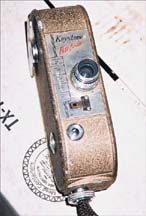
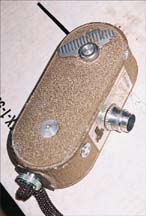
Keystone K-29 Movie Camera
Click to Enlarge
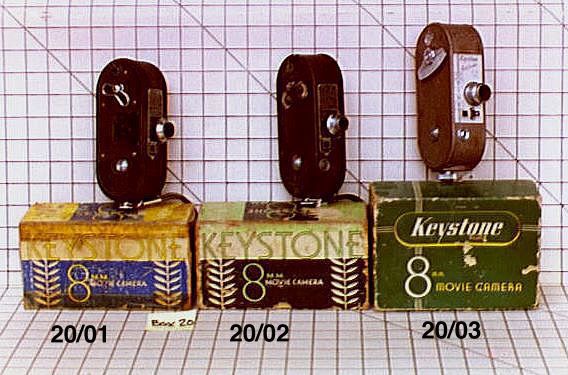
Companion Models and Boxes
This is Keystone Pathfinder camera, Model K-29, made in about 1956. It uses 8mm "Double 8" film, made by Keystone Mfg. Co. Hallet Sq Boston,24 Mass. The lens is the Keystone-Elgeet 1/2" f:2.8 It uses a spring mechanism to drive the film.
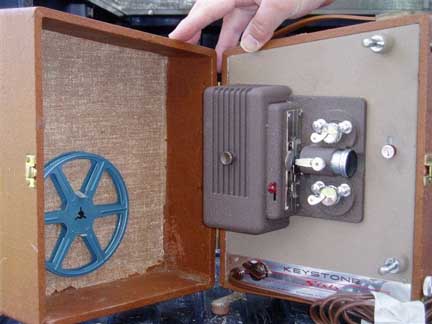
Keystone Model 60 Projector
Above is the Keystone Movie Projector that would have been used with the results obtained by using the K-29
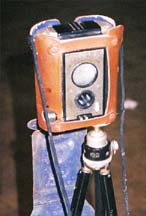
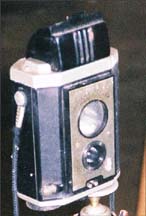
Brownie Synchro Reflex
Click to Enlarge
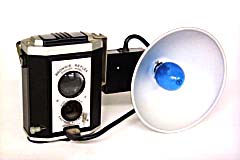
With the Flash
This is a Brownie Synchro Reflex Camera, produced between 1941 and 1952. The original price was $ 6.00. It uses roll film No. 127; 1-5/8 x 2-1/2. It has a Meniscus lens and has an Eastman Rotary Shutter, I & B. The third photo shows the synchro-reflex with an optional with Brownie Reflex Flasholder; (flash originally $4.00); uses its fixed 25 mm Lens and with only Filter Attachments available.
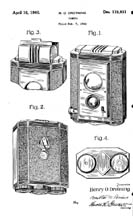
Brownie Synchro Reflex Design Patent
Patent D-119,931
Click to Enlarge
Rolleiflex is the name of a long-running and diverse line of high-end cameras made by the German company Rollei. The "Rolleiflex" name is most commonly used to refer to Rollei's premier line of medium format twin lens reflex (TLR) cameras. (A companion line intended for amateur photographers, Rolleicord, existed for several decades.) However, a variety of TLRs and SLRs in medium, 35 mm, and digital formats have also been produced under the Rolleiflex label. The Rolleiflex series is marketed primarily to professional photographers.
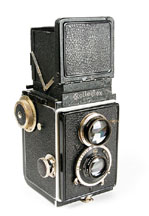
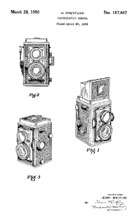

The Rolleiflex Twin Lens Reflex Camera
Design Patent D-157,847
$51.95 in 1939 would be equal to $1600 in 2009
Click to Enlarge
These cameras were not (and are not) cheap. In 1939 the Rollei sold for about $52 -- a sum that would be about $1600 in 2009.
The Rolleiflex TLR film cameras were notable for their compact size, reduced weight, superior optics, durable and simple mechanics and bright viewfinders. An ingenious tapered mirror allowed the size of the viewing lens (the top lens) 'internal compartment' to be reduced, and this smaller compartment was dovetailed with the bottom taking lens 'compartment', which decreased the overall size and weight of the camera. The high-quality lenses, manufactured by Zeiss and Schneider, further differentiated the Rolleiflex TLR from many of its competitors. The mechanical wind mechanism was robust and clever, making film loading semi-automatic and quick. A wide range of accessories made this camera a more complete system, allowing close-ups, added filters and quick tripod attachment. Some art photographers still shoot with Rolleiflex TLR film cameras and black-and-white film, the later 2.8F and 3.5F models being very popular. Modern Rolleiflex TLRs are still being manufactured; available focal lengths include 50mm, 80mm, and 135mm. The late-model cameras are collectible, particularly in Japan
Polaroid photography was invented by Edwin Land. In the late 1920s, as an undergraduate at Harvard University, Edwin Land conceived and produced the first modern filters to polarize light (patented 1929), and formed a company to market them for use in sunglasses, glare-free automobile headlights, and stereoscopic (i.e., virtual "3-D") photography. But it was through his Polaroid Corporation (founded 1937) that Land was immortalized, for his invention and marketing of instant photography.
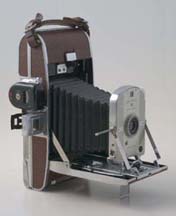
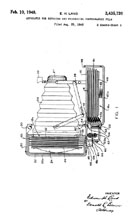
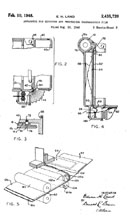
The Polaroid Land Camera
Edwin Land Patent No.2,435,720
Click to Enlarge
Inspired by his three year old daughter, who had asked him why she couldn't see a photo he had taken of her right away, Land created a system of one-step photography (first demonstrated at a meeting of the Optical Society of America in February 1947). Land used the principle of diffusion transfer to reproduce the image recorded by the camera's lens directly onto a photosensitive surface---which now functioned as both film and photo. The Polaroid Land camera was first offered for sale on November 26th, 1948, in a handsome case designed by Walter Dorwin Teague.

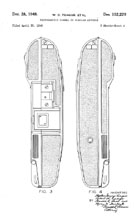
The Polaroid Land Camera Design Patent
Walter Dorwin Teague Design Patent D-152,229
Click to Enlarge
Land continued to improve his invention: "Polacolor" film made instant color photos possible in 1963; in 1972, the "SX-70" replaced the wet, peel-apart development process with dry films that developed in light. The "Swinger" was a low-priced, easy-to-use camera that sold very briskly, aided by witty commercials featuring James Garner and Mariette Hartley. (Land even created an instant color movie-making system, "Polavision," in 1978; but this never enjoyed the commercial success of his still-photography cameras.)
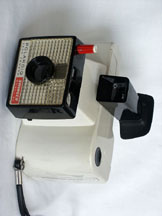

The Polaroid Swinger
Dreyfuss et al Polaroid Swinger Camera Patent No. 3,498,197
Click to Enlarge
Land spent his entire adult life experimenting and innovating in the field of optics, from producing recording systems used by the U.S. in World War II to proposing the "retinex" theory of human color perception. Land is among the top inventors who have been granted U.S. patents, with over 500 to his credit. Land's contributions can perhaps best be gauged by the fact that he was awarded the Medal of Freedom---the highest honor granted to civilians in the U.S.

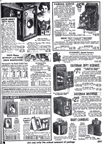
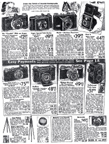
From Sears Catalogues in the 1930s
(left) 1930 (middle) 1935 (right) 1939
Click to Enlarge
Sears was amajor source for cameras in the nation's heartland. They appear to have offered a wide variety of camera models and price levels. Their customer base was apparently sophisticated enough to understand terms like chromatic aberration and "rectilinear lens. Multiply the prices in the catalogues by about 30 to get an approximate idea of what these prices would be in 2009 dollars. If you don't believe that there has been that much inflation, see out Cost of Things page.
Counter for the Entire Site (not just this page..)
Home | About Lindy | 1940s Collectibles | Upcoming Events | Vintage Clothing
The Guide - Establishments - Travel - Accessories
Music | Links | Photo Gallery | Extras | Contact